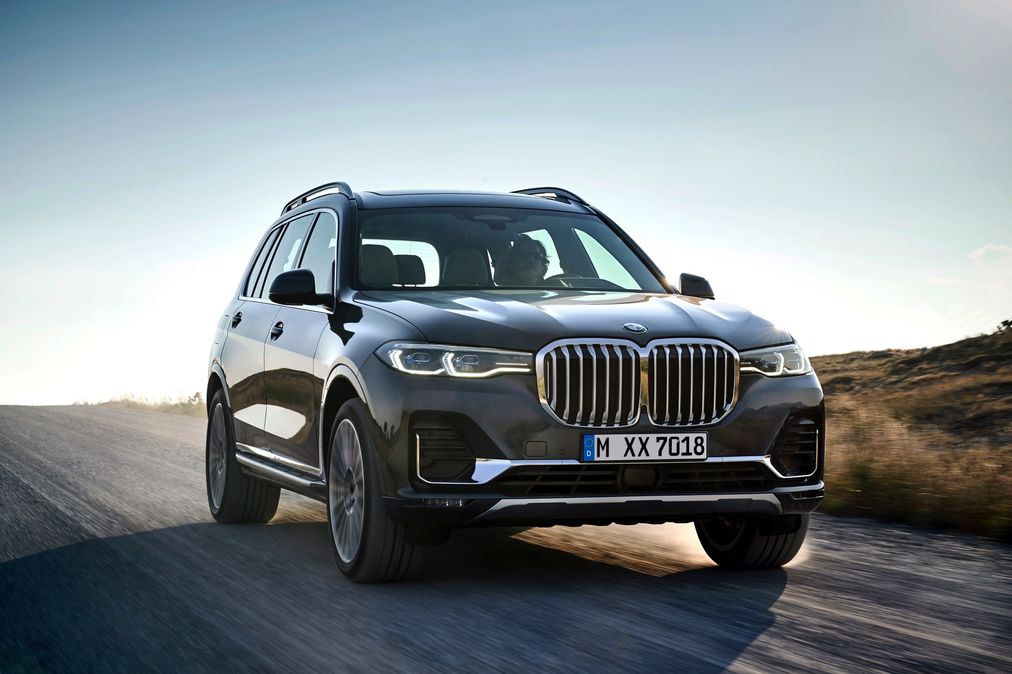Test drive: BMW X7 is a big SUV with big presence
BMW super-sizes the SUV to deliver extra legroom in the back rows and added appeal in the driver's seat.

In medical terms, swollen kidneys are very bad news. It means the fist-sized pair of bean-shaped organs located either side of the spine are failing to maintain the body’s fluid balance.
Conversely, a set of swollen kidney grilles are a sign of excellent financial health; and none are more engorged than the items affixed to the front of a BMW X7. The big seven-seat SUV was launched in 2019 to complement the five-seat X5, and counter similar oversized offerings from prestige rivals.
Some commentators have likened the X7’s gaping, double-kidney grille to beaver teeth, but we prefer to merely note that the adornment – affixed in varying sizes to all models of the BMW clan – is proportional to the rest of the vehicle’s epic dimensions.
More than a merely ostentatious display of automotive snobbery, the grille features integrated active air flaps that open and close to increase cooling or improve aerodynamic efficiency. Not that aerodynamics are necessarily a forte of a 2320kg SUV that is both longer and wider than Toyota’s burly 200 Series LandCruiser.
A very big deal
Crucially for fecund fans of the Bavarian brand, moving multiple people in a considerable degree of luxury, is.
Compared to its 5-Series-based X5 stablemate, the X7 sits on a 7-Series platform and is around 229mm longer overall. That’s may not sound like much, but it frees up crucial second and third row legroom, while creating a tad more luggage space.
Our entry-level X7 xDrive 30d test car ($119,900 plus on-road costs; $143,050 as tested) was loaded with some $23k of extra flashness, including full ‘Merino’ leather trim ($4500), five-zone air-con ($1800) and heated and cooled cupholders ($500), among the extras.
The big-ticket item was BMW’s $15K Pure Excellence package which, to an already extensive standard features list, adds such kit as 22-inch alloys, Alcantara headliner, Harman Kardon surround sound, laser lights, ‘satinated’ roof rails, and lots more.
The competitive landscape
Comparing its circa $120K base price against actual rivals, the X7 xDrive 30d is around $15k more expensive than Audi’s Q7 3.0 TDI Quattro, but line-ball with Benz’s GLS350d, which boasts near identical power and torque outputs to the BMW’s 195kW/620Nm.
If those figures sound familiar, that’s likely because they’re identical to the outputs of the X5 30d, which packs the same 3.0-litre, inline six-cylinder twin-turbocharged diesel engine.
And what an engine it is. The turbos serve up a seamless wave of torque virtually from idle, with nary a flat spot or a hint of coarseness anywhere, propelling the big blunderbus to 100km/h in an impressive-for-the-size 7.0 seconds.
Twist and shout
That’s all well and good until the first corner, at which point it dawns that getting something this big and softly-sprung to turn in might be quite the challenge.
To be fair, the X7 is designed to ferry a full load of humans in quiet comfort, not to see how quickly you can make them turn green in the twisties. Even at lower velocities, though, you notice its tendency to push the nose wider in corners.
You can tighten things up courtesy of selectable drive modes (Sport, Comfort, Eco and Adaptive). The air suspension adapts to your wishes, along with the throttle mapping and shift sensitivity of the excellent ZF eight-speed automatic.
The same self-levelling air suspension comes in handy when it’s time to load or unload, dropping by 40mm at the press of a button, or adding extra ground clearance if venturing off-piste.
Spacious and clever
Boot capacity is a reasonable 326 litres with all three rows of seats in place, expanding to 750 litres with the third row folded, or a delivery van-like 2120 litres with both the second and third rows stowed.
Achieving the latter is relatively easy, thanks to a handy array of switches in the cargo bay that provide electric control of the various split-fold seat configurations.
Both upper and lower sections of the two-piece tailgate are similarly electrically operated, with a foot-operated gesture control switch beneath the rear bumper.
Creating the wow factor
Gesture control also lends some wow factor to the front pews, where driver or passenger can wave a finger in the air in front of the high-res 12.3-inch display to adjust audio volume, or access other features and menus in BMW’s impressive infotainment system.
Every seat features multi-mode electrical adjustment, while the headrests on the outer pews of the second row boast little puffy leather pillows for longer trips.
Third-row passengers are especially well looked after, with individual overhead controls for air-con and their own mini sunroof, along with cupholders, air vents and electric seat switches to aid ingress and egress.
Despite this, getting in and out of that third row is not for the stiff of limb or spine, requiring some dexterity to manoeuvre. And just remember to mind your kidneys on the way out.











Hi Guest, join in the discussion on Test drive: BMW X7 is a big SUV with big presence